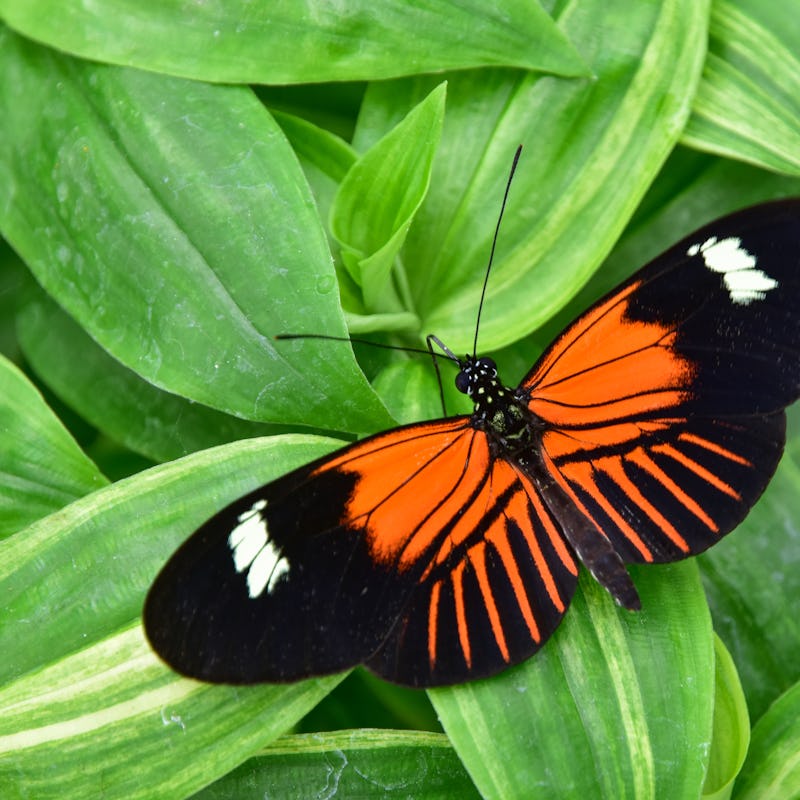Weird butterfly genetics counter popular theory of evolution
Cross-breeding is thought of as a bad thing, but hybridization holds its advantages.

A deep dive into the genetics of butterflies offers new clues as to how these pollinators shared DNA across generations.
Interbreeding among different species of Heliconius, a brightly colored genus of butterfly, contradict traditional ideas about the negative effects of hybridization, according to a new study. The results, published Thursday in the journal Science, give new insight into the role of gene flow in evolution.
Nate Edelman, a graduate student at Harvard University and an author on the study, tells Inverse that hybridization is traditionally thought of as a bad thing.
Hybrid animals tend to be associated with their faults: Like the mule, the offspring of a male donkey and a female horse, which can’t itself reproduce.
“That hybrid usually has some big problems,” says [Edelman]. “That’s sort of the baseline expectation.”
But Heliconius butterflies are keen cross-breeders, it turns out. Edelman’s team looked at a subset of the butterfly population and found that one-third of the different species can mate with other species in the same genus. The scope of hybridization within the butterflies’ genomes was larger than expected.
As individual butterflies breed across species, it makes sense for their genomes to keep only beneficial traits and do away with less helpful ones. Mimicry is an example of a “good” genetic trait: Heliconius is beautifully colored to warn predators that they’re toxic and shouldn’t be eaten. The butterflies mimic each other to “share the cost of warning predators,” Edelman says.
Hybridization wasn’t limited to helpful genes, however.
“We found it was really widespread across the whole genome,” says Edelman. That suggests there’s a clear evolutionary advantage to mixing up the genome for this kind of butterfly — running counter to a popular theory about evolution.
One-third of *Heliconius* species studied can mate with other species, researchers found.
Evolution is generally thought of as a linear process: Species split off from one another over time, move to different places, and adapt different traits. But species like those in the Heliconius genus make patterns of evolution more interesting.
“We need to take into account in our evolutionary models that we can get gene flow between species,” Edelman says.
Heliconius made sense to study because of its hybrid-making tendencies. It’s also just a cool really insect. The adult Heliconius eats pollen, which no other butterfly does. And Heliconius is smart, Edelman says. It has a “home range,” meaning it will go to visit the same flower every day, a habit more commonly associated with mammals.
Cross-breeding between helonicus butterfly species has come with its special benefits.
The findings have potential implications for conservation and preserving pollinator populations. Studies show that species variation is key to protecting those populations in a changing climate.
“One good thing about genetic diversity is if you have a really variable and diverse population, when environmental conditions change, you have a better chance of responding to them,” Edelman says.
So how does hybridization factor in? Researchers don’t all agree on whether it’s likely to contribute to genetic diversity. But it very well might.
“It’s at least somewhat likely that you’re going to increase your variation rather than decrease it,” Edelman says.
Conservation can involve protecting species by keeping out its close relatives, to avoid hybridization or a species takeover, but for species like these butterflies, that strategy may not work as well.
“Hybridization is pretty common in nature,” Edelman says. “In some cases it might be good to bring in other species and increase genetic diversity for conservation purposes.”